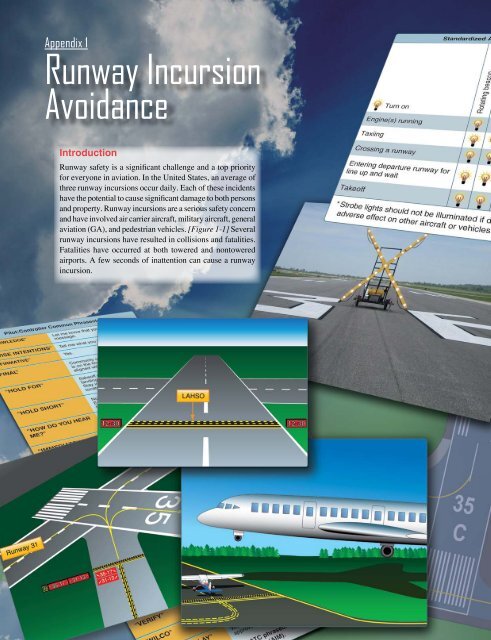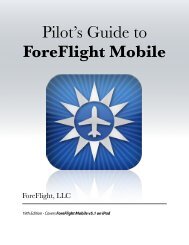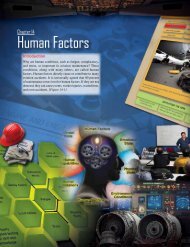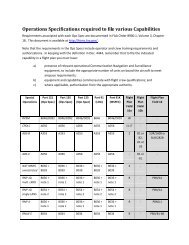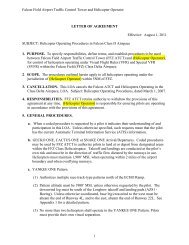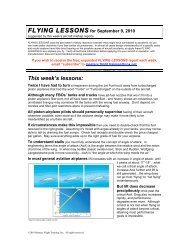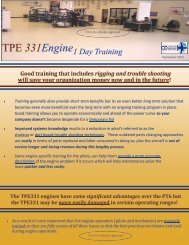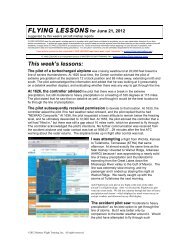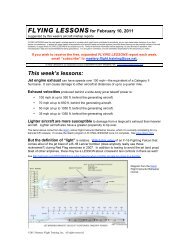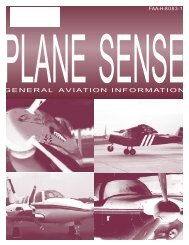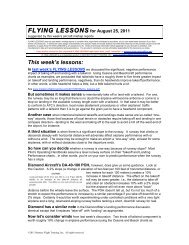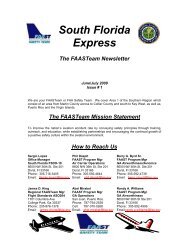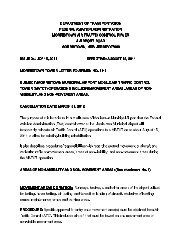Appendix 1, Runway Incursion Avoidance - FAA
Appendix 1, Runway Incursion Avoidance - FAA
Appendix 1, Runway Incursion Avoidance - FAA
- No tags were found...
You also want an ePaper? Increase the reach of your titles
YUMPU automatically turns print PDFs into web optimized ePapers that Google loves.
<strong>Appendix</strong> 1<strong>Runway</strong> <strong>Incursion</strong><strong>Avoidance</strong>Introduction<strong>Runway</strong> safety is a significant challenge and a top priorityfor everyone in aviation. In the United States, an average ofthree runway incursions occur daily. Each of these incidentshave the potential to cause significant damage to both personsand property. <strong>Runway</strong> incursions are a serious safety concernand have involved air carrier aircraft, military aircraft, generalaviation (GA), and pedestrian vehicles. [Figure 1-1] Severalrunway incursions have resulted in collisions and fatalities.Fatalities have occurred at both towered and nontoweredairports. A few seconds of inattention can cause a runwayincursion.1-1
• Automatic Terminal Information Service (ATIS)• Notice to Airmen (NOTAMs)—http://www.faa.gov/pilots/flt_plan/notams• Advisory Circular (AC) 91-73, part 91 and part 135,Single-Pilot and Flight School Procedures During TaxiOperations• Aeronautical Information Manual (AIM)—www.faa.gov/air_traffic/publications/atpubs/aim/• AC 120-74, parts 91, 121, 125, and 135, Flight CrewProcedures During Taxi OperationsFigure 1-1. <strong>Runway</strong> incursions are a top <strong>FAA</strong> safety concern thatinvolves pilots, air traffic control (ATC), and ground operations.You are expected to taxi an airplane safely whether movingto or from a runway or otherwise moving about the airport.Scenarios such as bad weather, low visibility, construction,airport unfamiliarity, time of day, distractions, fatigue, andmiscommunications with air traffic control (ATC) add greatlyto the challenge of surface navigation.This chapter is designed to help you attain an understandingof the risks associated with surface navigation and is intendedto provide you with basic information regarding the safeoperation of aircraft at towered and nontowered airports. Thischapter focuses on the following major areas:• <strong>Runway</strong> incursion overview• Taxi route planning• Taxi procedures• Communications• Airport signs, markings and lightingEach section identifies best practices to help you avoid errorsthat may potentially lead to runway incursions. Although thechapter pertains mostly to surface movements for single-pilotoperations, all of the information is relevant for flight crewoperations as well.Additional information about surface operations is availablethrough the following sources:• Federal Aviation Administration (<strong>FAA</strong>) <strong>Runway</strong>Safety website—www.faa.gov/go/runwaysafety• <strong>FAA</strong> National Aeronautical Navigation Services(AeroNav), formerly known as the NationalAeronautical Charting Office (NACO)—www.faa.gov/air_traffic/flight_info/aeronav• Airport/Facility Directory (A/FD)—www.faa.gov/air_traffic/flight_info/aeronav/productcatalog/supplementalcharts/airportdirectory<strong>Runway</strong> <strong>Incursion</strong> OverviewApproximately three runway incursions occur each day attowered airports within the United States. The potentialthat these numbers present for a catastrophic accident isunacceptable. A runway incursion is formally defined bythe <strong>FAA</strong> as “any occurrence at an aerodrome involving theincorrect presence of an aircraft, vehicle, or person on theprotected area of a surface designated for the landing andtakeoff of aircraft.” The following are examples of pilotdeviations, operational incidents (OI), and vehicle (driver)deviations that may lead to runway incursions.Pilot Deviations:• Crossing a runway hold marking without clearancefrom ATC• Taking off without clearance• Landing without clearanceOperational Incidents (OI):• Clearing an aircraft onto a runway while anotheraircraft is landing on the same runway• Issuing a takeoff clearance while the runway isoccupied by another aircraft or vehicleVehicle (Driver) Deviations:• Crossing a runway hold marking without ATCclearanceAccording to <strong>FAA</strong> data, approximately 65 percent of allrunway incursions are caused by pilots. Additionally, 75percent of the 65 percent of runway incursions are causedby GA pilots.Causal Factors of <strong>Runway</strong> <strong>Incursion</strong>sDetailed investigations of runway incursions over the past10 years have identified three major areas contributing tothese events:• Failure to comply with ATC instructions1-2
HOT SPOTSSW-4, 08 MAR 2012 to 05 APR 2012SW-4, 08 MAR 2012 to 05 APR 2012PHOENIX DEER VALLEY (DVT)For information purposes only. Not an official airport diagramNot to be used for navigationSW-4, 08 MAR 2012 to 05 APR 2012Figure 1-8. When taxiing, be aware of your location as it relatesto the intended taxi route, other aircraft, and vehicles operatingon the airport.Figure 1-9. Low sun angle is obscuring the runway holding positionsign and marking at a taxiway/runway intersection.Figure 1-7. Airport diagram for Phoenix Deer Valley (DVT),Phoenix, Arizona showing where the “hot spots” are located onthe airport.SA should be used at all times when operating on an airfield.For example, prior to brake release for taxi, minimize cockpittasks, observe “sterile flight deck” procedures, and alwayspractice a “heads up, eyes out” mode while taxiing. Remainespecially vigilant of “hold short,” crossing clearances,and “hot spots,” if applicable. When taxiing, be aware ofyour location as it relates to the intended taxi route, otheraircraft that are taxiing, and vehicles operating on the airport.[Figure 1-8] If in doubt, stop, remain clear of the runway,and contact ATC.The following excerpt, taken from the A/FD, is an exampleof information available to you that helps mitigate the loss ofSA: “Taxiing aircraft should use caution in early morning andlate afternoon hours. Sun glare may make visual recognitionof signs and pavement markings difficult.” [Figure 1-9]Movement and Non-Movement Area BoundaryAt towered airports, the airport surface area is divided intotwo parts: non-movement area and movement area. Thenon-movement area is defined as ramps and aprons and isnot controlled by ATC, which means you may move or taxithe airplane without clearance or communications with thecontrol tower.The movement area is defined as all taxiways and runwaysand is under the jurisdiction of the control tower, so a taxiclearance is required prior to entering into the movementarea. The boundary between the ramp and the taxiways iscalled the non-movement area boundary and is defined bytwo yellow lines: one solid and one dashed. [Figure 1-10]The solid line is located on the non-movement area side whilethe dashed yellow line is located on the movement area side.Once you are ready to taxi, ATC should be contacted for taxiinstructions. After a taxi clearance is received, movement tocross the non-movement area boundary marking and onto thetaxiway is authorized.1-6
Read back your complete ATC clearance with your aircraftcall sign. This gives ATC the opportunity to clarify anymisunderstandings and ensure that instructions were given tothe correct aircraft. If, at any time, there is uncertainty aboutany ATC instructions or clearances, ask ATC to “say again”or ask for progressive taxi instructions.Movement areaNon-movement areaFigure 1-10. Non-movement area boundary marking.ATC InstructionsTitle 14 of the Code of Federal Regulations (14 CFR) part91, section 91.123 requires you to follow all ATC clearancesand instructions. Request clarification if you are unsure of theclearance or instruction to be followed. If you are unfamiliarwith the airport or unsure of a taxi route, ask ATC for a“progressive taxi.” Progressive taxi requires the controllerto provide step-by-step taxi instructions.ATC Instructions—“Hold Short”The most important sign and marking on the airport is thehold sign and hold marking. These are located on a stubtaxiway leading directly to a runway. They depict the holdingposition or the location where the aircraft is to stop so as notto enter the runway environment. [Figure 1-12] For example,Figure 1-13 shows the holding position sign and marking for<strong>Runway</strong> 13 and <strong>Runway</strong> 31.The final decision to act on ATC’s instruction rests with you.If you cannot safely comply with any of ATC’s instructions,inform them immediately by using the word “UNABLE.”There is nothing wrong with telling a controller that you areunable to safely comply with the clearance.Another way to mitigate the risk of runway incursions is towrite down all taxi instructions as soon as they are receivedfrom ATC. [Figure 1-11] It is also helpful to monitor ATCclearances and instructions that are issued to other aircraft.You should be especially vigilant if another aircraft has asimilar sounding call sign so there is no mistake about whoATC is contacting or to whom they are giving instructionsand clearances.Figure 1-12. Do NOT cross a runway holding position markingwithout ATC clearance.Figure 1-13. <strong>Runway</strong> 13-31 holding position sign and markinglocated on taxiway Charlie.Figure 1-11. A pilot writing down instructions from ATC.1-7
When ATC issues a “hold short” clearance, you are expectedto taxi up to, but not cross any part of the runway holdingmarking. At a towered airport, runway hold markings shouldnever be crossed without explicit ATC instructions. Do notenter a runway at a towered airport unless instructions aregiven from ATC to cross, takeoff from, or “line up and wait”on that specific runway.ATC is required to obtain a read-back from the pilot ofall runway “hold short” instructions. Therefore, youmust read back the entire clearance and “hold short”instruction, to include runway identifier and your call sign.Figure 1-14 shows an example of a controller’s taxi and “holdshort” instructions and the reply from the pilot.ControllerNovember 477ZA,runway four, taxi viaEcho, hold short runwaytwo five at taxiway Delta.PilotNovember 477ZA,runway four via Echo,hold short of runwaytwo five at Delta.Figure 1-14. Example of taxi and “hold short” instructions fromATC to a pilot.ATC Instructions—Explicit <strong>Runway</strong> CrossingAs of June 30, 2010, ATC is required to issue explicitinstructions to “cross” or “hold short” of each runway.Instructions to “cross” a runway are normally issued oneat a time, and an aircraft must have crossed the previousrunway before another runway crossing is issued. Exceptionsmay apply for closely spaced runways that have less than1,000 feet between centerlines. This applies to all runwaysto include active, inactive, or closed. Figure 1-15 showscommunication between ATC and a pilot who is requestinga taxi clearance.Pilot“Ground, November 1234ready to taxi from the GAramp with Bravo.”ATC“November 1234,<strong>Runway</strong> 27, taxi viaAlpha, hold short<strong>Runway</strong> 31.”Pilot“November 1234,<strong>Runway</strong> 27, taxi viaAlpha, hold short<strong>Runway</strong> 31.”ATCWhen able, tower willissue crossing clearance:“November 1234, cross<strong>Runway</strong> 31.”Figure 1-15. Communication between ATC and a pilot who isrequesting taxi procedures.ATC Instructions—“Line Up and Wait” (LUAW)ATC now uses the “line up and wait” (LUAW) instructionwhen a takeoff clearance cannot be issued immediately dueto traffic or other reasons. The words “line up and wait” havereplaced “position and hold” in directing you to taxi onto arunway and await takeoff clearance.An ATC instruction to “line up and wait” is not a clearancefor takeoff. It is only a clearance to enter the runway andhold in position for takeoff. Under LUAW phraseology, thecontroller states the aircraft call sign, departure runway, and“line up and wait.” Be aware that “traffic holding in position”will continue to be used to advise other aircraft that traffichas been authorized to line up and wait on an active runway.Pay close attention when instructed to “line up and wait,”especially at night or during periods of low visibility. Beforeentering the runway, remember to scan the full length of therunway and its approach end for other aircraft.There have been collisions and incidents involving aircraftinstructed to “line up and wait” while ATC waits for thenecessary conditions to issue a takeoff clearance. An OIcaused a 737 to land on a runway occupied by a twin-engineturboprop. The turboprop was holding in position awaitingtakeoff clearance. Upon landing, the 737 collided with thetwin-engine turboprop.Extra caution should be used when directed by ATC totaxi onto or across a runway, especially at night and duringreduced visibility conditions. Always comply with “holdshort” or crossing instructions when approaching an entranceto a runway. Scan the full length of the runway and the finalapproaches before entering or crossing any runway, even ifATC has issued a clearance.When ATC instructs you to “line up and wait,” they shouldadvise you of any delay in receiving your takeoff clearance.Possible reasons for ATC takeoff clearance delays mayinclude other aircraft landing and/or departing, waketurbulence, or traffic crossing an intersecting runway. Iflanding traffic is a factor, ATC is required to:• Inform you of the closest traffic requesting a full-stop,touch-and-go, stop-and-go, option, or unrestricted lowapproach on the same runway.1-8
• Advise the landing traffic that traffic is holding inposition on the same runway.• If advised of a reason for the delay, or the reason isclearly visible, expect an imminent takeoff clearanceonce the reason is no longer an issue.• If a takeoff clearance is not received within 90 secondsafter receiving the “line up and wait” instruction,contact ATC immediately.• When ATC issues intersection “line up and wait”instructions and takeoff clearances, the taxiwaydesignator is included.NOTE: At night or in low visibility, consider lining upslightly left or right of centerline when holding for takeoffso that your aircraft is visible and can be differentiated fromrunway lights.ATC Instructions—“<strong>Runway</strong> Shortened”You should review NOTAMs in your preflight planning todetermine any airport changes that will affect your departureor arrival. When the available runway length has beentemporarily or permanently shortened due to construction,the ATIS includes the words “warning” and “shortened” inthe text of the message. For the duration of the constructionwhen the runway is temporarily shortened, ATC willinclude the word “shortened” in their clearance instructions.Furthermore, the use of the term “full length” will not beused by ATC during this period of the construction. Someexamples of ATC instructions are:• “<strong>Runway</strong> 36 shortened, line up and wait.”• “<strong>Runway</strong> 36 shortened, cleared for takeoff.”• “<strong>Runway</strong> 36 shortened, cleared to land.”When an intersection departure is requested on a temporarilyor permanently shortened runway during the construction,the remaining length of runway is included in the clearance.For example, “<strong>Runway</strong> 36 at Echo, intersection departure,5,600 feet available.” If following the construction, therunway is permanently shortened, ATC will include theword “shortened” until the A/FD is updated to include thepermanent changes to the runway length.Pre-Landing, Landing, and After-LandingWhile en route and after receiving the destination airportATIS/landing information, review the airport diagramand brief yourself as to your exit taxiway. Determine thefollowing:• Are there any runway hold markings in close proximityto the exit taxiway?• Do not cross any hold markings or exit onto anyrunways without ATC clearance.After landing, use the utmost caution where the exit taxiwaysintersect another runway, and do not exit onto another runwaywithout ATC authorization. Do not accept last minuteturnoff instructions from the control tower unless you clearlyunderstand the instructions and are at a speed that ensures youcan safely comply. Finally, after landing and upon exitingthe runway, ensure your aircraft has completely crossed overthe runway hold markings. Once all parts of the aircraft havecrossed the runway holding position markings, you must holdunless further instructions have been issued by ATC. Do notinitiate non-essential communications or actions until theaircraft has stopped and the brakes set.Aircraft LightsThe use of aircraft exterior lights during all flight operationsmake an aircraft operating on the airport surface moreconspicuous and help convey location and intent to you andATC. Some examples of aircraft exterior light usage are listedbelow and shown in Figure 1-16.Turn onEngine(s) runningTaxiingCrossing a runwayEntering departure runway forline up and waitTakeoffStandardized Aircraft LightingRotating beaconNavigation/Position lightsStrobe light*Taxi lightsLogo lightsLanding lights* Strobe lights should not be illuminated if doing so will have anadverse effect on other aircraft or vehicles.Figure 1-16. Standard aircraft lighting.• Engines running—before starting engines, turn on therotating beacon.• Taxiing—prior to commencing taxi, turn onnavigation/position, strobe (only if the use of themdoes not adversely affect other aircraft), taxi, and logolights, if available.1-9
• Crossing a runway—illuminate all external lightswhen crossing a runway. You should consider anypossible adverse affects that illuminating the forwardfacing lights may have on the vision of other pilots orground personnel during runway crossings.• “Line up and wait”—when entering the departurerunway without takeoff clearance, turn on all exteriorlights (except landing lights) to make your aircraftmore conspicuous.• Departure runway—when entering the departurerunway after takeoff clearance is received or whencommencing takeoff roll, turn on landing lights.Nontowered AirportsMany GA airports, even those with operating ATC towers,may not have airport signage and markings that are requiredat airports certificated by the <strong>FAA</strong>. In fact, you may observea wide range of airport signage and markings from one GAairport to the next.There is no substitute for alertness while in the vicinity of anairport. It is essential that pilots be alert and look for othertraffic and exchange traffic information when approachingor departing an airport without an operating control tower.This is of particular importance since other aircraft may nothave communication capability or, in some cases, pilots maynot communicate their presence or intentions when operatinginto or out of such airports. To achieve the greatest degree ofsafety, it is essential that all radio-equipped aircraft transmit/receive on a common frequency identified for the purposeof airport advisories.An airport may have a full or part-time tower or FlightService Station (FSS) located on the airport, a full or parttimeUNICOM station, or no aeronautical station at all. Thereare three ways for pilots to communicate their intention andobtain airport/traffic information when operating at an airportthat does not have an operating tower: by communicatingwith an FSS, a UNICOM operator, or by making a selfannouncedbroadcast.Many airports are now providing completely automatedweather, radio check capability, and airport advisoryinformation on an automated UNICOM system. Thesesystems offer a variety of features, typically selectable bymicrophone clicks, on the UNICOM frequency. Availabilityof the automated UNICOM is published in the A/FD andapproach charts.NOTE: Line up and wait/holding in position is notrecommended at nontowered airports.CommunicationsIn order to have safe surface operations, it is imperativethat you maintain good communication with ATC. Thecontroller’s understanding can be enhanced by you respondingappropriately and using standard phraseology. Figure 1-17shows a detailed glossary of phraseology that is commonlyused in surface operations. Guidelines for clear and accuratecommunications include the use of proper communicationprocedures when contacting ATC. Your initial transmissionto ATC should contain the following elements:• Who you are—aircraft’s complete call sign.• Where you are on the airport.• What you want—you should think about what youwant to say before communicating it.• Alphabetical code for the ATIS.NOTE: You must be alert for stuck microphones.Prior to contacting ATC, transmissions should be wellthought out before keying the transmitter. Know what needsto be said and always check the radio frequencies to ensurethat the proper one is being used to transmit. Communicationwith ATC should be concise and to the point. For unusualsituations or lengthy communications, initial contact shouldbe established. Then, in the next transmission, describe thesituation. Keep in mind that other aircraft are waiting tocontact ATC, so transmissions should be kept to a minimumunless it is an emergency situation.While communicating with ATC, focus on what the controlleris instructing and do not perform any non-essential tasks.Refer to the AIM, Chapter 5, Section 5, Pilot/ControllerRoles and Responsibilities. Read back any “hold short”of runway instructions issued by ATC. This readback should include the specific runway designator andtaxiway intersection when appropriate, so if there are anymisunderstandings or errors, they are obvious to ATC.A read back presents the first and most efficient opportunity tocatch any miscommunications. It provides a “reality check” intwo ways: it tells the controller, “This is what the pilot heard;”and it provides the controller the opportunity to reaffirm thatis what he/she meant to say. For detailed information aboutradio communication phraseology and techniques, refer toChapter 4, Section 2 of the AIM.Understanding the NOTAMs for the airport is very importantwhen communicating with ATC. NOTAMs provideinformation regarding taxiway/runway closures. With properknowledge of the airport’s NOTAMs, you can assist ATC.1-10
“ACKNOWLEDGE”Pilot/Controller Common Phraseology“ADVISE INTENTIONS”“AFFIRMATIVE”“FINAL”“HOLD FOR”“HOLD SHORT”“HOW DO YOU HEARME?”“IMMEDIATELY”“LINE UP AND WAIT”“NEGATIVE”“READ BACK”“ROGER”“STAND BY”“UNABLE”“VERIFY”“WILCO”“WITHOUT DELAY”Let me know that you have received mymessage.Tell me what you plan to do.Yes.Commonly used to mean that an aircraftis on the final approach course or isaligned with a landing area.(takeoff clearance, release,landing/taxiing aircraft, etc.)Stay in place where you are currentlylocated.November 477ZA, runway four, taxi viaEcho, hold short runway two five attaxiway Delta.A question relating to the quality of thetransmission or to determine how wellthe transmission is being received.Used by ATC or pilots when such actioncompliance is required to avoid animminent situation.Used by ATC to inform a pilot to taxionto the departure runway in takeoffposition and LINE UP and WAIT.It is not authorization for takeoff.It is used when takeoff clearance cannotimmediately be issued because of trafficor other reasons.“No” or “permission not granted” or“that is not correct.”Repeat my message back to me.I have received all of your lasttransmission. It should not be used toanswer a question requiring a yes orno answer.(See Affirmative, Negative)Means the controller or pilot must pausefor a few seconds, usually to attend toother duties of a higher priority. Alsomeans to wait, as in “stand by forclearance.” The caller should reestablishcontact if a delay is lengthy. “Stand by”is not an approval or denial.Indicates inability to comply with aspecific instruction, request, orclearance.Request confirmation of information (forexample, “verify assigned altitude”).I have received your message,understand it, and will comply with it.With a sense of urgency, proceed withapproved instructions in a rapid manner.For a complete listing of all ATC phraseology, consult theAeronautical Information Manual (AIM).Figure 1-17. Standard phraseology that should be used betweenpilots and ATC.For example, if ATC clears you to taxi on a closed taxiwayor runway, you can inform them. If you are unsure of anyportion of the taxi clearance, request clarification and/orprogressive taxi instructions. It is important for you to knowthat you can request assistance.NOTE: When instructed to “monitor” a particular frequency,listen on the frequency and stand by for instructions. Undernormal circumstances, do not initiate communications.Examples of Taxi InstructionsInitial Call-up with Specific RequestsPilot: Teterboro ground, Gulfstream November322ZQ, ACME aviation, with informationAlpha, request taxi to <strong>Runway</strong> one niner.Controller: November 322ZQ, Teterboro ground, <strong>Runway</strong>one niner, taxi via Lima.“Line Up and Wait”Controller: November 523QQ, <strong>Runway</strong> two seven, “line upand wait,” traffic landing <strong>Runway</strong> three right.Pilot: November 523QQ, <strong>Runway</strong> two seven, “line upand wait.”“Line Up and Wait” on Intersecting <strong>Runway</strong>s“Line up and wait” can be authorized on intersecting runways.When this is done, traffic advisories shall be issued to bothaircraft.Departure Instructions for Two AircraftController: November 523QQ, <strong>Runway</strong> three six at Golffour, “line up and wait,” traffic departing<strong>Runway</strong> two seven.Pilot: N523QQ, <strong>Runway</strong> three six at Golf four, “lineup and wait.”Controller: November 144NM, <strong>Runway</strong> two seven, clearedfor takeoff, traffic holding in position <strong>Runway</strong>three six.Departure and Arrival Instructions for Two AircraftController: November 477ZA, <strong>Runway</strong> six, “line up andwait,” traffic landing <strong>Runway</strong> two seven.Pilot: November 477ZA, <strong>Runway</strong> six, “line up andwait.”Controller: November 234AG, <strong>Runway</strong> two seven, clearedto land, traffic holding in position <strong>Runway</strong> six.1-11
Intersection Departure ClearanceATC must state the name of the intersection to you beforea “line up and wait” instruction. You should question ATCif this does not happen. You should state that they are at anintersection when requesting a takeoff clearance. A controllermust also state the name of the intersection when issuing atakeoff clearance.Controller: November 477ZA, <strong>Runway</strong> four, TaxiwayBravo, “line up and wait.”Pilot: “Line up and wait,” <strong>Runway</strong> four, TaxiwayBravo, November 477ZA.Ensure that when you read back a clearance for an intersection“line up and wait” or intersection takeoff, you state the nameof the intersection, even if the controller did not include itin the clearance.Landing ClearanceATC may withhold or rescind a landing clearance when anaircraft is in “line up and wait” on the runway.Landing Clearance WithheldController: November 477ZA, <strong>Runway</strong> four, continue,traffic holding in position.Landing Clearance CancelledController: November 477ZA, landing clearance cancelled,traffic holding in position, continue.Takeoff Clearance/Landing ClearanceRead back all landing and takeoff clearances with a call sign,including the runway designator.Controller: November 123QY, Charlotte tower, <strong>Runway</strong>four right, cleared to land.Pilot: November 123QY, cleared to land, <strong>Runway</strong> fourright.Controller: November 123QY, Charlotte tower, <strong>Runway</strong>five, cleared for takeoff.Pilot: November 123QY, cleared for takeoff, <strong>Runway</strong>five.Land and “Hold Short” ClearanceLand and “hold short” instructions require your acceptanceand read back.Controller: November 123QY, Waterloo Tower, <strong>Runway</strong>three six, cleared to land, hold short <strong>Runway</strong>three zero for departing traffic.Pilot: November 123QY, cleared to land <strong>Runway</strong> threesix, hold short <strong>Runway</strong> three zero.Figure 1-18A and B shows an example of the land and “holdshort” holding position.<strong>Runway</strong> Exiting ClearanceAfter landing and reaching taxi speed, you are expected toexit the runway at the first available taxiway or as instructedby ATC. You should remain on the tower frequency untiladvised to contact ground control.Controller: Unity three two, turn right on Taxiway Golf twoand contact ground point niner when clear of therunway.Pilot: Unity three two, right on Golf two, ground pointniner.Initial Contact After Landing and Clearing the<strong>Runway</strong>Pilot: Lincoln ground, November 123QY, clear of<strong>Runway</strong> two at Bravo, taxi to the ramp.Controller: November 123QY, Lincoln ground, taxi to theramp via Bravo.Light Gun SignalsATC has a backup system if radio communication fails.Controllers use a light gun that flashes different colors toinstruct you what to do. Refer to the Pilot’s Handbook ofAeronautical Knowledge, Chapter 13, Airport Operations, fora light gun signal illustration. Even a failed radio transmissionis not an excuse for proceeding without a proper clearance.If you are on a runway or taxiway and radio communicationwith ATC fails, you should:1. Turn toward the tower.2. Flash your landing lights several times.3. Wait for the light signal from ATC.4. Be patient. If ATC’s attention is diverted, it may takea few minutes for a response.5. If your radios are working, try a frequency other thanthe one you are currently using.6. Call ATC via cell phone if you have the numberavailable.1-12
ANC-3, 08 MAR 2012 to 05 APR 2012BLAHSO12-30 12-30Not to be used for navigationNC-3, 08 MAR 2012 to 05 APR 2012Figure 1-18. (A) Airport diagram of Waterloo Regional Airport (ALO) showing the LAHSO holding position. (B) Intersection of <strong>Runway</strong>36 and <strong>Runway</strong> 12-30 at Waterloo Regional Airport. LAHSO hold markings across <strong>Runway</strong> 36 are clearly visible along with the twocollocated <strong>Runway</strong> 12-30 hold signs.1-13
Signs, Markings, and LightingIt is important for you to know the meanings of the signs,markings, and lights that are used on airports as surfacenavigational aids. All airport markings are painted on thesurface, whereas some signs are vertical and some are paintedon the surface. An overview of the most common signs andmarkings are described on the following pages. For moredetailed information on runway signs and markings, referto the AIM.<strong>Runway</strong> Holding Position SignNoncompliance with a runway holding position sign mayresult in the <strong>FAA</strong> filing a Pilot Deviation against you.A runway holding position sign is an airport version of astop sign. [Figure 1-19] It may be seen as a sign and/or itscharacters painted on the airport pavement. The sign has whitecharacters outlined in black on a red background. It is alwayscollocated with the surface painted holding position markingsand is located where taxiways intersect runways. On taxiwaysthat intersect the threshold of the takeoff runway, only thedesignation of the runway may appear on the sign.Figure 1-20. <strong>Runway</strong> holding position sign at a location other thanthe takeoff end of <strong>Runway</strong> 18-36 with collocated Taxiway Alphalocation sign.runways are shown on the sign along with arrows showing theapproximate alignment of each runway. [Figure 1-21A and B]In addition to showing the approximate runway alignment,the arrows indicate the direction(s) to the threshold of therunway whose designation is immediately next to eachcorresponding arrow.This type of taxiway and runway/runway intersectiongeometry can be very confusing and create navigationalchallenges. Extreme caution must be exercised when taxiingonto or crossing this type of intersection. Figure 1-21A and Bshows a depiction of a taxiway, runway/runway intersectionand is also designated as a “hot spot” on the airport diagram.In the example, Taxiway Bravo intersects with two runways,31-13 and 35-17, which cross each other.Figure 1-19. <strong>Runway</strong> holding position sign at takeoff end of <strong>Runway</strong>14 with collocated Taxiway Alpha location sign.If a taxiway intersects a runway somewhere other than atthe threshold, the sign has the designation of the intersectingrunway. The runway numbers on the sign are arranged tocorrespond to the relative location of the respective runwaythresholds. Figure 1-20 shows “18-36” to indicate thethreshold for <strong>Runway</strong> 18 is to the left and the threshold for<strong>Runway</strong> 36 is to the right. The sign also indicates that youare located on Taxiway Alpha.If the runway holding position sign is located on a taxiwayat the intersection of two runways, the designations for bothSurface painted runway holding position signs may also beused to aid you in determining the holding position. Thesemarkings consist of white characters with a black borderon a red background and are painted on the left side of thetaxiway centerline. Figure 1-22 shows a surface paintedrunway holding position sign that is the holding point for<strong>Runway</strong> 32R-14L.You should never allow any part of your aircraft to cross therunway holding position sign (either a vertical or surfacepainted sign) without a clearance from ATC. Doing so posesa hazard to yourself and others.When the tower is closed or you are operating at a nontoweredairport, you may taxi past a runway holding position signonly when the runway is clear of aircraft, and there areno aircraft on final approach. You may then proceed withextreme caution.1-14
A<strong>Runway</strong> 31B 35-17 31-1335-1731-13NC-3, 08 MAR 2012 to 05 APR 201235<strong>Runway</strong> 13Not to be used for navigationNC-3, 08 MAR 2012 to 05 APR 2012BFigure 1-21. (A) Taxiway Bravo location sign collocated with runway/runway intersection holding signs at Sioux Gateway Airport (SUX)(B) Airport diagram of Sioux Gateway Airport (SUX), Sioux City, Iowa. The area outlined in red is a designated “hot spot” (HS1).1-15
operating at a nontowered airport, you may taxi onto or acrossthe runway only when the runway is clear and there are noaircraft on final approach. You should use extreme cautionwhen crossing or taxiing onto the runway and always lookboth ways.When exiting the runway, the same markings will be seenexcept the aircraft will be approaching the double dashedlines. [Figure 1-24] In order to be clear of the runway, theentire aircraft must cross both the dashed and solid lines.An ATC clearance is not needed to cross this marking whenexiting the runway.Figure 1-22. Surface painted runway holding position signs for<strong>Runway</strong> 32R-14L along with the enhanced taxiway centerlinemarking.<strong>Runway</strong> Holding Position MarkingNoncompliance with a runway holding position markingmay result in the <strong>FAA</strong> filing a Pilot Deviation against you.<strong>Runway</strong> holding position markings consist of four yellowlines, two solid and two dashed, that are painted on the surfaceand extend across the width of the taxiway to indicate wherethe aircraft should stop when approaching a runway. Thesemarkings are painted across the entire taxiway pavement, arein alignment, and are collocated with the holding positionsign as described above.As you approach the runway, two solid yellow lines andtwo dashed lines will be visible. Prior to reaching the solidlines, it is imperative to stop and ensure that no portion ofthe aircraft intersects the first solid yellow line. Do not crossthe double solid lines until a clearance from ATC has beenreceived. [Figure 1-23] When the tower is closed or whenFigure 1-23. Surface painted holding position marking along withenhanced taxiway centerline.Figure 1-24. <strong>Runway</strong> holding position markings as seen whenexiting the runway. When exiting the runway, no ATC clearanceis required to cross.Enhanced Taxiway Centerline MarkingsAt most towered airports, the enhanced taxiway centerlinemarking is used to warn you of an upcoming runway.It consists of yellow dashed lines on either side of thenormal solid taxiway centerline and the dashes extend upto 150 feet prior to a runway holding position marking.[Figure 1-25A and B] They are used to aid you in maintainingawareness during surface movement to reduce runwayincursions.Elevated <strong>Runway</strong> Guard LightsElevated runway guard lights (ERGL), commonly knownas “wig-wag” lights, are collocated with the runway holdposition signs and surface painted hold position markings.They consist of a pair of elevated flashing yellow lightsinstalled on either side of the taxiway near the holdingposition sign. [Figure 1-26A] Alternatively, they may be arow of in-pavement yellow lights installed across the taxiwayat the holding position marking. [Figure 1-26B] <strong>Runway</strong>guard lights are effective visual aids for helping you identifythe runway holding position.1-16
AAEnhanced taxiway centerline marking extends 150 feet priorto a runway holding position marking. Prepare to STOP.BBPrepare to STOP unless you have been cleared ontoor across the runway by ATC.Figure 1-25. (A) Enhanced taxiway centerline marking. (B)Enhanced taxiway centerline marking and runway position marking.<strong>Runway</strong> Safety Area Boundary SignIn addition to the runway hold marking, some taxiway stubsalso have a runway safety area boundary sign that faces therunway and is visible to you only when exiting the runway.This sign has a yellow background with black markingsand is typically used at towered airports where a controllercommonly requests you to report clear of a runway. This signis intended to provide you with another visual cue that is usedas a guide to determine when you are clear of the runwaysafety boundary area. The sign shown in Figure 1-27 is whatyou would see when exiting the runway at Taxiway Kilo,and is out of the runway safety area boundary when theentire aircraft passes the sign and the accompanying surfacepainted marking.Land and Hold Short Operations (LAHSO)When simultaneous operations (takeoffs and landings) arebeing conducted on intersecting runways, Land and HoldShort Operations (LAHSO) may also be in effect. LAHSOis an ATC procedure that may require your participation andcompliance. As pilot in command (PIC), you have the finalauthority to accept or decline any LAHSO clearance.Figure 1-26. (A) Elevated flashing yellow runway guard lights alsoreferred to as “wig-wag” lights. (B) In-pavement flashing yellowrunway guard lights.Figure 1-27. <strong>Runway</strong> safety area boundary sign and marking locatedon Taxiway Kilo.If issued a land and hold short clearance, you must be awareof the reduced runway distances and whether or not you cancomply before accepting a land and hold short clearance. Youdo not have to accept a LAHSO clearance. Pilots should onlyreceive a LAHSO clearance when there is a minimum ceilingof 1,000 feet and 3 statute miles of visibility.1-17
<strong>Runway</strong> holding position signs and markings are installedonly on those runways used for LAHSO. The signs andmarkings are placed at the LAHSO point to aid you indetermining where to stop and hold the aircraft and are locatedprior to the runway/runway intersection. [Figure 1-28]If you accept the following clearance from ATC: “Clearedto land <strong>Runway</strong> 36 hold short <strong>Runway</strong> 23-5,” you musteither exit <strong>Runway</strong> 36 or stop at the holding position priorto <strong>Runway</strong> 23-5.Location Signs and MarkingsTaxiway location signs and markings and runway locationsigns aid you in identifying the taxiway or runway on whichyou are currently located. They have a black backgroundwith yellow characters. These signs may stand alone or becollocated with direction or runway holding position signs.[Figure 1-29A and B]AFigure 1-28. <strong>Runway</strong> holding position sign and marking for LAHSO.The holding position sign has a white inscription with blackborder around the numbers on a red background and isinstalled adjacent to the holding position markings. If youaccept a land and hold short clearance, you must complyso that no portion of the aircraft extends beyond these holdmarkings.BIf receiving “cleared to land” instructions from ATC, youare authorized to use the entire landing length of the runwayand should disregard any LAHSO holding position markingslocated on the runway. If you receive and accept LAHSOinstructions, you must stop short of the intersecting runwayprior to the LAHSO signs and markings.Below is a list of items which, if thoroughly understoodand complied with, will ensure that LAHSO operations areconducted properly.• Know landing distance available.• Be advised by ATC as to why LAHSO are beingconducted.• Advise ATC if you cannot comply with LAHSO.• Know what signs and markings are at the LAHSOpoint.• LAHSO are not authorized for student pilots who areperforming a solo flight.• Generally, LAHSO are not authorized with air carrieroperations.• Generally, LAHSO are not authorized at night.• LAHSO are not authorized on wet runways.36-1830-12C3030Figure 1-29. (A) Taxiway Alpha location sign. (B) <strong>Runway</strong> 36location sign. (C) <strong>Runway</strong> thresholds of <strong>Runway</strong> 30 and <strong>Runway</strong>36, which are nearly collocated.361-18
<strong>Runway</strong> location signs are intended to complement theinformation available to you through your aircraft magneticcompass. They are installed in areas where the proximityof two or more runways could cause you to be confused.Figure 1-29A and B shows that Taxiway Alpha and <strong>Runway</strong>36 are stand alone location signs and are not associated withany other sign.[Figure 1-31] Direction signs are normally located onthe left side of the taxiway and prior to the intersection.These signs and markings (with a yellow background andblack characters) indicate the direction toward a differenttaxiway, leading off a runway, or out of an intersection.Figure 1-31 shows Taxiway Delta and how Taxiway Bravointersects ahead at 90° both left and right.Complex airport geometry, a single taxiway leading tomultiple runway thresholds, and/or the close proximity ofmultiple runway thresholds can lead to confusion and ahigher risk of you departing on the wrong runway. At airportswhere these risk factors are present and the proximity of tworunway thresholds could cause confusion, runway locationsigns may be present. Cross-check your aircraft compassheading with the assigned takeoff runway heading prior tobrake release. Figure 1-29C shows the thresholds of <strong>Runway</strong>30 and <strong>Runway</strong> 36, which are collocated. <strong>Runway</strong> locationsigns are present on these runways along with the runwaydesignation numbers.NOTE: <strong>Runway</strong> designation surface painted markings arelarge white block numbers and are located at the thresholdof the runway.Surface painted taxiway location markings are normallylocated on airports where there has been a history ofnavigation confusion. [Figure 1-30] These signs andmarkings are designed to help you navigate difficult orpotentially confusing intersections. If ever in doubt aboutyour taxi clearance, ask ATC for help.Figure 1-31. Taxiway Bravo direction sign with a collocatedTaxiway Delta location sign. When the arrow on the directionsign indicates a turn, the sign is located prior to the intersection.Taxiway direction signs can also be displayed as surfacepainted markings. Figure 1-32 shows Taxiway Bravo asproceeding straight ahead while Taxiway Alpha turns to theright at approximately 45°.AFigure 1-30. Surface painted Taxiway Alpha location sign.Taxiway Direction Signs and MarkingTaxiway direction signs have a yellow background andblack characters, which identifies the designation orintersecting taxiways. Arrows indicate the direction of turnthat would place the aircraft on the designated taxiway.Figure 1-32. Surface painted taxiway direction signs.Figure 1-33A and B shows an example of a direction sign ata complex taxiway intersection. Figure 1-33A and B showsTaxiway Bravo intersects with Taxiway Sierra at 90°, but at45° with Taxiway Foxtrot. This type of array can be displayedwith or without the taxiway location sign, which in this casewould be Taxiway Bravo.1-19
AFSSSFBSFBFBFigure 1-33. (A) Orientation of signs is from left to right in a clockwise manner. Left turn signs are on the left and right turn on theright. In this view, the pilot is on taxiway Bravo. (B) Direction sign array at a complex taxiway/taxiway intersection.Destination SignsDestination signs have black characters on a yellowbackground indicating a destination at the airport. Thesesigns always have an arrow showing the direction of the taxiroute to that destination. [Figure 1-34] When the arrow onthe destination sign indicates a turn, the sign is located priorto the intersection. Destinations commonly shown on thesetypes of signs include runways, aprons, terminals, militaryareas, civil aviation areas, cargo areas, international areas,and fixed-base operators. When the inscription for two ormore destinations having a common taxi route are placedon a sign, the destinations are separated by a “dot” (•) andone arrow would be used as shown in Figure 1-35. Whenthe inscription on a sign contains two or more destinationshaving different taxi routes, each destination is accompaniedby an arrow and separated from the other destination(s) on1-20
The ILS critical area boundary sign has white characters,outlined in black, on a red background and is installedadjacent to the ILS holding position markings. [Figure 1-36]The holding position markings for the ILS critical area appearon the pavement as a horizontal ladder and consist of twosolid yellow lines spaced two feet apart connected by pairsof solid lines spaced ten feet apart extending across the widthof the taxiway.Figure 1-34. Destination sign to the fixed-base operator (FBO).Figure 1-36. Instrument landing system (ILS) holding position signand marking on Taxiway Golf.Figure 1-35. <strong>Runway</strong> destination sign with different taxi routes.the sign with a vertical black message divider as shown inFigure 1-35. The example shown in Figure 1-35 shows twosigns. The sign in the foreground explains that <strong>Runway</strong> 20threshold is to the left, and <strong>Runway</strong>s 32, 2, and 14 are tothe right. The sign in the background indicates that you arelocated on Taxiway Bravo and Taxiway November will takeyou to those runways.Holding Position Signs and Markings for anInstrument Landing System (ILS)The instrument landing system (ILS) broadcasts signals toarriving instrument aircraft to guide them to the runway. Eachof these ILSs has a critical area that must be kept clear of allobstacles in order to ensure quality of the broadcast signal.At many airports, taxiways extend into the ILS critical area.Most of the time, this is of no concern; however, during timesof poor weather, an aircraft on approach may depend on agood signal quality. When necessary, ATC will protect theILS critical area for arrival instrument traffic by instructingtaxiing aircraft to “hold short” of this critical area.When instructed to “hold short of the ILS critical area,” youmust ensure no portion of the aircraft extends beyond thesemarkings. If ATC does not instruct you to hold at this point,then you may bypass the ILS critical area hold positionmarkings and continue with your taxi. Figure 1-36 showsthat the ILS hold sign is located on Taxiway Golf and theILS ladder hold position marking is adjacent to the hold sign.<strong>Runway</strong> Approach Area Holding Position Signs andMarkingsAt some airports, it is necessary to hold an aircraft on ataxiway located in the approach or departure area for arunway so the aircraft does not interfere with operations onthat runway. In these situations, a sign with a designation ofthe approach end of the runway followed by a “dash” (–) andletters “APCH” will be located at the holding position on thetaxiway. Holding position markings will be located on thetaxiway pavement. [Figure 1-37] In this example, the signmay protect the approach to <strong>Runway</strong> 32 and/or the departurefor <strong>Runway</strong> 14. If you are expected to “hold short” of arunway approach (“APCH”) area, ATC will issue instructions.1-21
Temporarily Closed <strong>Runway</strong>s and TaxiwaysFor temporarily closed runways and taxiways, a visualindication is often provided with yellow “Xs” or raisedlighted yellow “Xs” placed at each end of the runway.Depending on the reason for the closure, duration of closure,airfield configuration, and the existence and the hours ofoperation of an ATC tower, a visual indication may not bepresent. As discussed previously in the chapter, you mustalways check NOTAMs and ATIS for runway and taxiwayclosure information.Figure 1-37. <strong>Runway</strong> 32 approach area sign and marking onTaxiway Alpha.Holding Position Markings for Taxiway/TaxiwayIntersectionsHolding position markings for taxiway/taxiway intersectionsconsist of a single dashed yellow line extending across thewidth of the taxiway. [Figure 1-38] They are painted ontaxiways where ATC normally holds aircraft short of ataxiway intersection. When instructed by ATC “hold shortof Taxiway X,” you should stop so that no part of youraircraft extends beyond the holding position marking. Whenthe marking is not present, you should stop your aircraft ata point that provides adequate clearance from an aircraft onthe intersecting taxiway.B GGBGFigure 1-39A shows an example of a yellow “X” laid flatwith an adequate number of heavy rubber weights to keep thewind from getting under and displacing the vinyl material.The black rubber weights are positioned along the edge givingthe appearance of a black outline.A very effective and preferable visual aid to depict temporaryclosure is the lighted “X” placed on or near the runwaydesignation numbers. [Figure 1-39B and C] This device ismuch more discernible to approaching aircraft than the othermaterials described above.<strong>Runway</strong> Edge and Centerline LightsThe runway edge lights are white, except on instrumentrunways where yellow replaces white on the last 2,000 feetor half the runway length, whichever is less, to form a cautionzone for landings.The lights marking the ends of the runway emit red lighttoward the runway to indicate the end of runway to adeparting aircraft and emit green outward from the runwayend to indicate the threshold to landing aircraft.GBB GCenterline lights are located along the runway centerlineand are spaced at 50-foot intervals. When viewed from thelanding threshold, the runway centerline lights are white untilthe last 3,000 feet of the runway. The white lights begin toalternate with red for the next 2,000 feet. For the last 1,000feet of the runway, all centerline lights are red. [Figure 1- 40]Figure 1-38. Holding position marking on a taxiway.Marking and Lighting of Permanently Closed<strong>Runway</strong>s and TaxiwaysFor runways and taxiways that are permanently closed, thelighting circuits are disconnected. The runway threshold,runway designation, and touchdown markings are obliteratedand yellow “Xs” are placed at each end of the runway andat 1,000-foot intervals.Taxiway Edge Lights or ReflectorsTaxiway edge lights or reflectors are blue in color and usedto outline the edges of taxiways. [Figure 1-41]<strong>Runway</strong> Designation Marking<strong>Runway</strong> numbers and letters are determined from theapproach direction. The runway number is the whole numbernearest one-tenth the magnetic azimuth of the centerline ofthe runway, measured clockwise from the magnetic north.1-22
AFigure 1-40. <strong>Runway</strong> lights.BCFigure 1-41. Blue taxiway edge lights.Figure 1-39. (A) Yellow “X” placed on surface of temporarily closedrunways. (B) Lighted “X” placed on temporarily closed runways.(C) Lighted “X” at night showing a temporarily closed runway.In the case where there are parallel runways, the lettersdifferentiate between left (L), right (R), or center (C).[Figure 1-42] For example, if there are two parallel runways,they would show the designation number and then either Lor R beneath it. For three parallel runways, the designationnumber would be presented with L, C, or R beneath it.1-23
35L35CFigure 1-42. Two of three parallel runways.1-24


